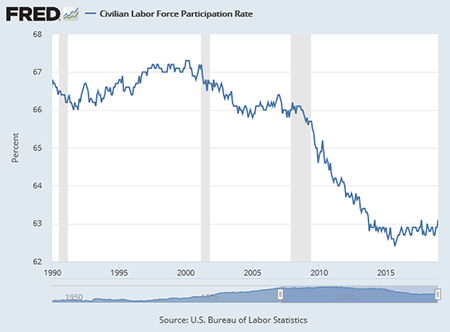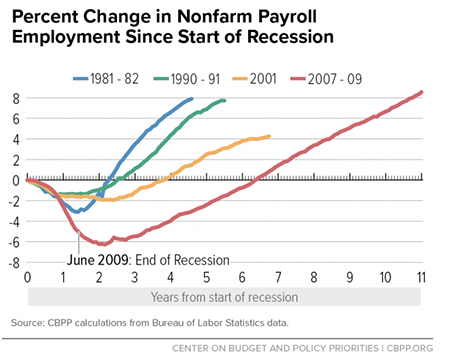Economic Concept: Unemployment – Causes, Solutions and Myths!
In Economics, unemployment is often treated as some sterile measure that can be easily adjusted up or down, and which is somewhat a natural byproduct of a modern economy. In real life, unemployment can be painful and debilitating, particularly if those unemployed have no emergency savings to rely upon until they find new jobs. Many people’s lives are defined by their work (“what do you do?” is probably the second question you are asked when meeting someone).
Work provides people with dignity, satisfaction and economic independence. This is probably why politicians discuss unemployment and jobs so frequently (because it matters to voters!). Unfortunately, unemployment statistics (as well as its causes and solutions) can be manipulated to win votes. Unemployment occurs when people cannot find a job even though they WANT to work. For the economy as a whole, the unemployment rate is calculated as a percentage: the number of unemployed workers as a proportion of all individuals currently in the labor force. In the U.S., government statistics add an additional restraint to the term: to be “unemployed,” a worker must be “actively seeking” work (as well as wanting a job).
The Six Measure of Unemployment
The U.S. Bureau of Labor Statistics compiles six measures of unemployment:
- U1: Percentage of labor force unemployed 15 weeks or longer.
- U2: Percentage of labor force that have lost jobs or completed temporary work.
- U3: Official “unemployment rate” – people without jobs that have actively looked for work within the past four weeks.
- U4: U3 + “discouraged workers,” or those who have stopped looking for work, because current economic conditions make them believe that no work is available for them.
- U5: U4 + other “marginally-attached workers,” or “loosely-attached workers,” or those who “would like” and are able to work, but have not looked for work recently.
- U6: U5 + Part-time workers who want to work full-time, but cannot due to economic reasons (underemployment).
The “U3” statistics is what is most commonly cited as the “Unemployment Rate.”
Frictional Unemployment
The Unemployment rate should not be expected to fall to 0%, because some “frictional” unemployment should always exist. Frictional unemployment is generally a result of the time and energy it takes to change jobs voluntarily (relocating, negotiating contracts, etc.) or obtain a new job after graduation from school. Employers, likewise, may have a job opening, but need time to review applications and interview candidates.
Cyclical Unemployment
“Cyclical” unemployment (mostly involuntary), occurs as a result of a downturn in the business cycle or an outright recession. As the economy slows (or even shrinks), businesses hire fewer workers and lay off current ones.
Structural Unemployment
“Structural” unemployment occurs when there is a mismatch between the skills and education of a noticeable portion of the labor force, and the skills needed for existing jobs. This mismatch can take a long time to resolve and can result in long-term unemployment for many workers. Likewise, the faster an economy changes (in terms of technology, patterns of trade and comparative advantages) the more likely that structural unemployment may develop.
Since the last recession ended, the formation of new jobs has been very slow by historical standards.
The official (U3) unemployment rate has fallen back to lower levels; however, many workers have simply stopped “actively seeking” a new job, so they no longer count as “unemployed”. Evidence of this can be found in the Labor Force Participation Rate (the percentage of the total population that is counted as “workers”). This figure has been dropping steadily for years.

Likewise, the portion of the population that is on some form of government assistance has skyrocketed, likely explaining part of the reasons why it is no longer “urgent” for some workers to actively seek employment.
Also, it is interesting that when the extended unemployment insurance payments expired at the end of 2013 (unemployment payments usually only last for 26 weeks, but were extended to almost two years by the Obama Administration), the unemployment rate dropped at an accelerating rate in early 2014. This suggests that unemployment benefits actually deter workers from seeking (and accepting) new jobs. In terms of economic incentives, as long as someone can pay their bills (with an unemployment check), why would they want to work unless working would make them better off (i.e. increase their total utility)?
Nonetheless, the recovery of jobs and employment since the last recession has been quite slow as compared to past recoveries

Underemployment
Underemployment occurs when workers have a job, but the job is either below their skill level (with corresponding lower pay) or they are unable to work as many hours as they would like (i.e. part time vs. full time).
Although politicians talk about how they have or will create jobs, governments do not actually create new jobs. Most jobs are created by new and small busineses (over 60% of net new jobs according to the Bureau of Labor Statistics). Government does not even help grow the economy; the best it can do is maintain a business friendly environment. The more government spends (stimulus programs, etc.) the more it must tax (take away from) the private sector and the jobs it creates.
In the meantime, thought you would enjoy this:
The “Who’s On First” Of Unemployment!
[I have tried to credit the original author (of which I am not), but have been unable to find the original source].
COSTELLO: I want to talk about the unemployment rate in America.
ABBOTT: Good Subject. Terrible Times. It’s 5.3%.
COSTELLO: That many people are out of work?
ABBOTT: No, that’s 23%.
COSTELLO: You just said 5.3%.
ABBOTT: 5.3% Unemployed.
COSTELLO: Right 5.3% out of work.
ABBOTT: No, that’s 23%.
COSTELLO: Okay, so it’s 23% unemployed.
ABBOTT: No, that’s 5.3%.
COSTELLO: WAIT A MINUTE. Is it 5.3% or 23%?
ABBOTT: 5.3% are unemployed. 23% are out of work.
COSTELLO: If you are out of work you are unemployed.
ABBOTT: No, Congress said you can’t count the “Out of Work” as the unemployed. You have to look for work to be unemployed. COSTELLO: BUT THEY ARE OUT OF WORK!!!
ABBOTT: No, you miss his point.
COSTELLO: What point?
ABBOTT: Someone who doesn’t look for work can’t be counted with those who look for work. It wouldn’t be fair.
COSTELLO: To whom?
ABBOTT: The unemployed.
COSTELLO: But ALL of them are out of work.
ABBOTT: No, the unemployed are actively looking for work. Those who are out of work gave up looking and if you give up, you are no longer in the ranks of the unemployed.
COSTELLO: So if you’re off the unemployment roles that would count as less unemployment?
ABBOTT: Unemployment would go down. Absolutely!
COSTELLO: The unemployment just goes down because you don’t look for work?
ABBOTT: Absolutely it goes down. That’s how it gets to 5.3%. Otherwise it would be 23%.
COSTELLO: Wait, I got a question for you. That means there are two ways to bring down the unemployment number?
ABBOTT: Two ways is correct.
COSTELLO: Unemployment can go down if someone gets a job? ABBOTT: Correct.
COSTELLO: And unemployment can also go down if you stop looking for a job?
ABBOTT: Bingo.
COSTELLO: So there are two ways to bring unemployment down, and the easier of the two is to have people stop looking for work.
ABBOTT: Now you’re thinking like an Economist.
COSTELLO: I don’t even know what the hell I just said!
ABBOTT: Now you’re thinking like a Politician.
http://www.cbpp.org/press/statements/statement-by-chad-stone-chief-economist-on-the-may-employment-report-2?fa=view&id=4153
http://www.nationalreview.com/corner/412777/study-2014s-employment-boom-almost-entirely-due-expiration-unemployment-benefits-obama
http://www.therepublicblog.com/2015/02/3-reasons-why-obama-shouldnt-be-celebrating-the-economy-just-yet/
